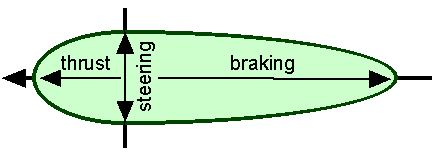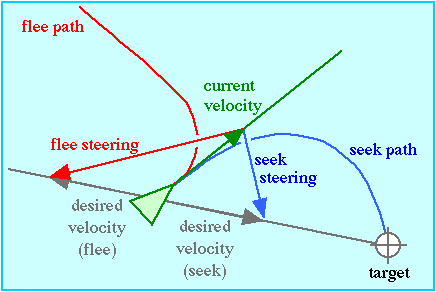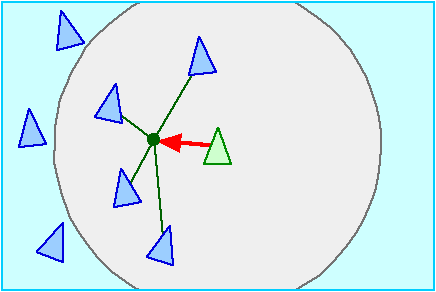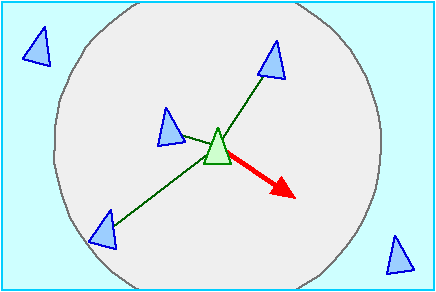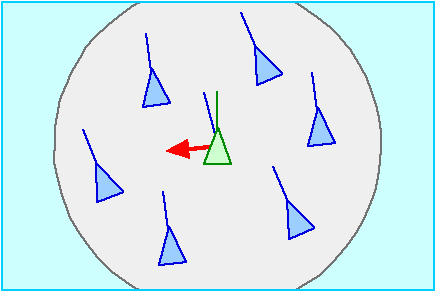Boids
Platform: Unity3D
Language: C#
Introduction
This is an overview of the boids algorithm as described in the 1999 Siggraph paper written by Craig Reynolds with some input from a post at www.kfish.org. In his paper, Reynolds describes three levels of control used to create "autonomous characters" and simulate their movements within a flock of birds or school of fish. These techniques have been used in countless movies, animations and video games. The levels of control can be broken down like this:
- action selection (highest)
- steering (middle)
- locomotion (lowest)
The action selection layer would involve strategies, goal selection and planning, while the lowest level, locomotion, only involves the underlying animation mechanics. Think about how a vehicle's animation layer would be handled quite differently than a bipedal creature, for instance, which would be driving a skeleton. The locomotion layer would deal with how that is implemented. For this project we are going to be focusing entirely on the middle layer; steering behaviors or "path determination". But first, let's talk about our boid.
The Mighty Boid
Our boid is an object with three properties: a position, a velocity (where it is heading and how fast) and a list of its neighbors within some distance. The image above shows how vectors pushing in different directions would affect our boid when applied. A vector pushing forward would cause our boid to speed up or maintain a certain velocity. While a force pushing it left or right would cause it to veer in another direction.
On every single frame, we will calculate each boid's new position and velocity by applying our steering behaviors to get a new velocity, then adding that to the previous position. We will also be using a "max speed" limiter so that none of our boids can move too fast, resulting in more natural motions.
Pseudcode
PROCEDURE UpdateBoids(Boids[] boids)
Vector v1, v2, v3
FOR EACH Boid b
v1 = rule1(b)
v2 = rule2(b)
v3 = rule3(b)
b.velocity = b.velocity + v1 + v2 + v3
b.position = b.position + b.velocity
END
END PROCEDURE
Later on we will look at the BoidManager class where we implement the above pseudocode and call UpdateBoids()
in the Update() lifecycle method we get from the MonoBehavior class in Unity.
Boid Class
Our Boid class is going to be where we describe our boid object and define our steering behaviors. Here we hold
our current Position, our current Velocity, and our Neighbors list, which gets updated each frame as well.
This script gets attached to an empty GameObject which we use to physically move our boid around in space. For the
purposes of this project, we will attach a mesh as a child to our empty GameObject and turn this into our Boid prefab.
Members
public Vector3 Position;
public Vector3 Velocity;
public List<Transform> Neighbors;
Constructor
Sets the Position and Velocity of the Boid and moves the parent transform with the geometry attached.
public Boid(Vector3 position, Vector3 velocity)
{
Position = position;
Velocity = velocity;
gameObject.transform.position = position;
gameObject.transform.rotation = Quaternion.LookRotation(Vector3.Normalize(velocity));
}
Methods
UpdateBoid
Identical to the constructor, this updates the Position and Velocity of the Boid and moves the parent transform with the geometry attached.
public void UpdateBoid(Vector3 position, Vector3 velocity)
{
Position = position;
Velocity = velocity;
gameObject.transform.position = position;
gameObject.transform.rotation = Quaternion.LookRotation(Vector3.Normalize(velocity));
}
UpdateNeighbors
Finds neighbors by distance and updates Neighbor List.
public void UpdateNeighbors(List<Transform> boids, float distance)
{
var neighbors = new List<Transform>();
for (var i = 0; i < boids.Count; ++i)
{
if (Position != boids[i].position)
{
if (Vector3.Distance(boids[i].position, Position) < distance)
{
neighbors.Add(boids[i]);
}
}
}
Neighbors = neighbors;
}
Steering Behaviors
- Seek
- Cohesion
- Separation
- Alignment
- Socialize (check repo for more info)
- Arrival (check repo for more info)
At the most basic level, a Steering Behavior is a function that returns a Vector (could be 2D or 3D, depending on your implementation) with the direction the boid should move to on the next frame based on some algorithm. On every update all of our boids have their next Velocity, then Position, calculated based on whatever list of Behaviors we have decided to use.
You can add as many Behaviors together as needed to get the movement you want, since all we are really doing is some simple vector math (v1 + v2 + v3 + ...). Let's say you have one Behavior that wants your boid to move two units to the right and another that says move one unit to the left. You end up just moving one unit to the right. Simple, right?
Note that in some of the Behavior's algorithms, we Normalize our vectors at different times depending on the desired effect. Read about normalization over at Khan Academy. They have great videos on YouTube walking you through everything you need to know about vectors.
The key to getting your flock of birds or school of fish working, is layering a combination of Cohesion,
Separation and Alignment. The more steering behaviors you define and use together, the more complex and
"lifelike" the overall effect will be. However, with only the Arrival behavior you can recreate a vehicle speeding to a
location, then slowing down and stopping at a specific point. The Boid class can be used in a wide variety of ways,
not only to simulate birds.
Now let's get our boids moving. The simplest way to do that would be to create the Seek steering behavior.
Seek
As taken directly from Reynold's paper:
Seek (or pursuit of a static target) acts to steer the character towards a specified position in global space. This behavior adjusts the character so that its velocity is radially aligned towards the target. Note that this is different from an attractive force (such as gravity) which would produce an orbital path around the target point. The “desired velocity” is a vector in the direction from the character to the target. The length of “desired velocity” could be max_speed, or it could be the character’s current speed, depending on the particular application. The steering vector is the difference between this desired velocity and the character’s current velocity.
Pseudocode
desired_velocity = normalize (position - target) * max_speed
steering = desired_velocity - velocity
In my implementation I use weight instead of max_speed as they are somewhat interchangeable and I set a max_speed
using the LimitVelocity() method which gets applied to the final Velocity after all the steering behaviors are
added together. See the git repo for how that algorithm is written.
C#/Unity 3D
public Vector3 Seek(Transform target, float weight)
{
if (weight < 0.0001f) return Vector3.zero;
var desiredVelocity = Vector3.Normalize(target.position - Position) * weight;
return desiredVelocity - Velocity;
}
The Seek behavior is given a target's position and simply returns a vector from the boid to that location. That becomes the raw desired_velocity. We then Normalize the vector, in other words, scale its Magnitude to 1.0. This means we now have a Vector pointing in the direction we want to go, but with a standardized length of 1 unit (in Unity, that is 1 meter). This then gets multiplied by a weight scalar value that we use for fine tuning.
Cohesion
The Cohesion steering behavior gives a boid the ability to cohere with (approach and form a group with) other nearby boids. Steering for cohesion can be computed by finding all boids in the local neighborhood and computing the average position of the nearby boids. The steering force can be applied in the direction of that average position (subtracting our boid's position from the average position).
Pseudocode
PROCEDURE Cohesion(Boid boid, Boid[] neighbors)
Vector pc
FOR EACH Neighbor n
pc = pc + n.position
END
pc = pc / neighbors.length
RETURN (pc - boid.position) / 100
END PROCEDURE
Notice at the end where we divide by 100. This would be equivalent to 1% towards the target position. Later in the actual code this becomes the steps argument. This is then multiplied by weight, which seems redundant, but it makes the values a little easier to reason about and conforms more closely with the other weights used later on.
C#/Unity 3D
public Vector3 Cohesion(float steps, float weight)
{
var pc = Vector3.zero; // Perceived Center of Neighbors
if (Neighbors.Count == 0) return pc;
// Add up the positions of the neighbors
for (var i = 0; i < Neighbors.Count; ++i)
{
var neighbor = Neighbors[i].GetComponent<Boid>();
if (pc == Vector3.zero)
{
pc = neighbor.Position;
}
else
{
pc = pc + neighbor.Position;
}
}
// Average the neighbor's positions
pc = pc / Neighbors.Count;
// Return the offset vector, divide by steps (100 would mean 1% towards center) and multiply by weight
return (pc - Position) / steps * weight;
}
Separation
The Separation steering behavior gives a boid the ability to maintain a certain separation distance from others nearby. This can be used to prevent boids from crowding together. To compute steering for separation, a repulsive force is calculated by subtracting the positions of our boid and its neighbors, normalizing, and then applying a 1/r2 weighting. (That is, the position offset vector is scaled by 1/r2. These repulsive forces for each nearby boid are summed together to produce the overall steering force. Reynolds points at that his formula 1/r2 worked for them, but this is not some mathematically perfect formula. You could come up with your own logic. Maybe you want your boids to separate based on the Intensity of their colors, or size...
Pseudocode
PROCEDURE Separation(Boid boid, Boid[] neighbors, float distance)
Vector c = 0;
FOR EACH Neighbor n
IF |n.position - boid.position| < distance THEN
c = c + (boid.position - n.position) / distance**2
END IF
END
RETURN c
END PROCEDURE
In the above pseudocode, |n.position - boid.position| is referring to the magnitude of the offset between the
two positions. Another way to say that is the distance between the two points (which would always be positive or at a
minimum be zero).
C#/Unity 3D
public Vector3 Separation(float steps, float weight)
{
var c = Vector3.zero; // Center point of a move away from close neighbors
for (var i = 0; i < Neighbors.Count; ++i)
{
var neighbor = Neighbors[i].GetComponent<Boid>();
var distance = Vector3.Distance(Position, neighbor.Position);
c = c + Vector3.Normalize(Position - neighbor.Position) / Mathf.Pow(distance, 2) / steps;
}
return c * weight;
}
Alignment
Similar to Cohesion, but instead of averaging the positions of the other boids we average their velocities. We
calculate a 'perceived velocity', pv, then add a small portion to the boid's current velocity to steer it in the
same direction of its neighbors.
Pseudocode
PROCEDURE Alignment(Boid boid, Boid[] Neighbors))
Vector pv
FOR EACH Neighbor n
pv = pv + n.velocity
END
pv = pv / Neighbors.count
RETURN (pv - n.velocity)
END PROCEDURE
C#/Unity 3D
public Vector3 Alignment(float weight)
{
Vector3 pv = Vector3.zero; // Perceived Velocity of Neighbors
if (Neighbors.Count == 0) return pv;
for (var i = 0; i < Neighbors.Count; ++i)
{
var neighbor = Neighbors[i].GetComponent<Boid>();
pv = pv + neighbor.Velocity;
}
// Average the velocities
if (Neighbors.Count > 1)
{
pv = pv / (Neighbors.Count);
}
// Normalize the offset vector and multiply by weight
return Vector3.Normalize(pv - Velocity) * weight;
}
Just a couple of notes about this one. If there are no Neighbors nearby, we immediately return Vector3.zero.
Remember that adding a Vector of zero has no effect whatsoever, just like adding zero to any number. Also, notice that
here we are normalizing the offset vector and then multiplying it by a weighting value, whereas in other steering
behaviors we might use a step value to get a smaller percentage of the raw vector, or sometimes we might just want to
use the offset vector as-is. There really is no "correct" answer here. You may want to choose a completely different
algorithm to get a similar result, or implement a standardized weighting system based on some world scale, or whatever
you decided makes sense to your project. The fun really starts when you begin to explore some new behaviors. Like, you
create a "too much coffee" steering behavior that actually introduces jitter. Why not?
BoidManager Class
My implementation of the BoidManager worked as a testing framework as I built my Boid class. The only real
difference between my UpdateBoids() and the pseudocode below is the additional LimitVelocity method I use so I can set a
max_speed and call UpdateNeighbors(). It is also where we Instantiate our boid prefabs on Start().
Pseudocode
PROCEDURE UpdateBoids(Boids[] boids)
Vector v1, v2, v3
FOR EACH Boid b
v1 = rule1(b)
v2 = rule2(b)
v3 = rule3(b)
b.velocity = b.velocity + v1 + v2 + v3
b.position = b.position + b.velocity
END
END PROCEDURE
C#/Unity 3D
private void UpdateBoids()
{
for (var i = 0; i < _boids.Count; ++i)
{
var boid = _boids[i].GetComponent<Boid>();
// Update its neighbors within a distance
boid.UpdateNeighbors(_boids, NeighborDistance);
// Steering Behaviors
var cohesionVector = boid.Cohesion(CohesionStep, CohesionWeight);
var separationVector = boid.Separation(SeparationStep, SeparationWeight);
var alignmentVector = boid.Alignment(AlignmentWeight);
var seekVector = boid.Seek(Target, SeekWeight);
var socializeVector = boid.Socialize(_boids, SocializeWeight);
var arrivalVector = boid.Arrival(Target, ArrivalSlowingDistance, ArrivalMaxSpeed);
// Update Boid's Position and Velocity
var velocity = boid.Velocity + cohesionVector + separationVector + alignmentVector + seekVector + socializeVector + arrivalVector;
velocity = boid.LimitVelocity(velocity, MaxVelocty);
velocity = boid.LimitRotation(velocity, 6.4f, MaxVelocty);
var position = boid.Position + velocity;
boid.UpdateBoid(position, velocity);
}
}
// Update is called once per frame
private void Update()
{
UpdateBoids();
}
Check the git repo for the full code and the scene you can open. Play around with the values in the BoidManager to test
out the different steering behaviors. I suggest adding weights in very small increments to start. Also, the key to
getting super smooth movement, is the use of the LimitVelocity() and LimitRotation() methods. What they do is
fairly easy to understand. One limits speed, the other limits the turning radius. However, their impact on the final
motion is extreme and my first attempts to make the Boid class work without them were disasters.
Click on the YouTube link at the top of the page to get to a playlist of some steering behaviors in motion.
Final Thoughts
Please read Reynold's Siggraph paper to fully appreciate his original work. I also want to mention kfish's idea for the overall max_speed limiter method, which I employed. On their web page they share a way of simulating an underwater current or wind force on the boids, which is surprisingly easy to understand once the ideas presented above make sense.
If your goal is to learn how to do this all yourself, I strongly suggest ignoring everything I wrote here and to start writing your own Boid class from scratch. Once you get Seek working, adding additional steering behaviors becomes easier.
For me, the next step is to translate all of this work into a B-Tree using Opsive's Behavior Designer plugin for Unity (the higher control level) and work on driving some skeletal animation based on speed (the locomotion level). Good luck and happy coding!

